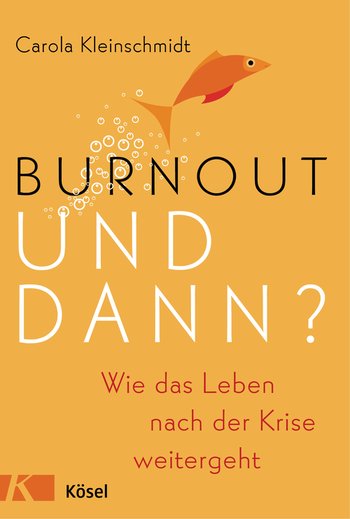
Burnout among employees: What managers need to know!
When a team colleague returns to work after a burnout, colleagues and managers almost always ask themselves with some concern: How should we deal with him or her? Will he or she be back at work? Carola Kleinschmidt is a trainer and expert on burnout and knows how managers can manage this balancing act.
Psychologist and Managing Director of Oberbergkliniken. For many years, she established concepts for mental health in the workplace in companies. Kentgens gives many educational talks and workshops in companies of all sizes, and wherever she goes, she always encounters the same uncertainty: "How do I as a colleague or boss deal with the person coming back from illness?
This is a question that concerns a lot of people," explains Kentgens. "The questioners in another department have often seen someone come back to the office but only stay at work for a few hours and then go home again. And they asked themselves: Is he allowed to do that because he was ill? Will that always be the case now?".
Reintegration after burnout: in stages from four to eight weeks
"There is usually a misunderstanding here," explains psychologist Kentgens. Bosses and colleagues often don't know that those returning to work are doing a phased reintegration . During this time, they are still officially on sick leave and the health insurance companies pay the wage costs.
As a rule, a gradual reintegration takes four to eight weeks. This period gives returnees the opportunity to gradually acclimatize to everyday working life and their activities again - without too much pressure. "During this time, special arrangements apply that are underpinned by medical or therapeutic advice. There is an agreed step-by-step plan, which is ideally agreed between the returnee, the person receiving treatment, the manager, the HR department, the works council and the company doctor," explains Kentgens. This means that it is quite possible that only a few hours of work per day have been agreed initially or that other special regulations apply to the employee during this time. Ideally, the employee's resilience will increase continuously.
How to deal with a colleague?
Of course, colleagues who don't know this quickly see someone from the outside who is only able to cope with little stress. And it is not uncommon for this initial image of the returnee to become established. A vicious circle can begin: You don't trust the employee to do much - and thus deprive them of the chance to fully reintegrate into day-to-day business.
"We therefore advise managers to communicate the employee's current status within the company to the team. Temporary special arrangements that have been negotiated with the person concerned, such as no business trips or reduced customer contact, should also be communicated so that the team is aware."
Such agreements can still apply between managers and employees even after gradual reintegration. Even then, it is best to communicate this to everyone. This transparency makes it much easier to reintegrate the returnee into the team and prevents rumors, false consideration and gossip.
After the burnout: no false consideration
Once reintegration is complete, which is usually the case after four to eight weeks, the employee is healthy again and can be fully deployed in the company.
"After reintegration and when any special arrangements have expired, the employee is considered fully resilient again," explains Kentgens. From the psychologist's point of view, this is the right thing to do, as there is a risk, especially after a mental health crisis, that the person will remain in a certain protective posture - or be pushed into the corner of "he's no longer resilient" by those around him out of false consideration."
Such developments are counterproductive for health and, above all, for recovery," explains Kentgens. The aim of reintegration is therefore for the employee to be able to return to their old job with the usual stresses and strains. Ideally, after successful treatment, the employee's attitude, resilience and resistance to stress will have improved - including the ability to say "no" from time to time.
"The biggest concern of those affected is that they will be looked at the wrong way when they return to the company."
If the employee notices before returning to work or during the reintegration process that they no longer want to carry out certain activities that were previously part of their duties, then it is not up to the manager or team to automatically take them off their hands. Rather, it is up to the employee to change their tasks and workload, explains Kentgens. This means that they can negotiate their tasks with their manager and also at HR department level in order to make the work suitable for them.
Talks as part of the reintegration process can also be the place for such adjustments. For example, some burnout sufferers want to reduce their working hours or look after fewer customers than before, and in some cases also want to move to other positions with less responsibility. "This clear appeal to the personal responsibility and clarity of those formerly affected may sound rigid," says Kentgens. But she knows from the everyday experience of therapists who work with burnout sufferers: "The biggest concern of those affected is that they will be looked at the wrong way for months after returning to the company, that they are no longer trusted to do anything and that this is precisely why they will not be able to perform again". Clarity in the reintegration process counteracts this discrimination and is therefore beneficial - for everyone involved.
About Carola Kleinschmidt:
 Carola Kleinschmidt is a graduate biologist, journalist and certified trainer (additional training in communication psychology, Schulz-von-Thun Institute/University of Hamburg).
Carola Kleinschmidt is a graduate biologist, journalist and certified trainer (additional training in communication psychology, Schulz-von-Thun Institute/University of Hamburg).
She has been working on the topic of "health and the world of work" for 15 years. Stern magazine described her non-fiction book "Bevor der Job krank macht" (Before the job makes you ill) as "one of the best books on the subject of burnout". It has sold over 25,000 copies. Follow-up books: "Das hält keiner bis zur Rente durch" (2014), "Burnout - und dann?" (2016). Carola Kleinschmidt gives lectures and workshops in organizations and companies on the topic of "Good Work & Mental Health". www.carolakleinschmidt.de
Literature tip: "Burnout - and then?" (2016)
 Every year, millions of people get back to life after a burnout. They all ask themselves: How will my life go on? Should I expect relapses? What and how much do I need to change in my life?
Every year, millions of people get back to life after a burnout. They all ask themselves: How will my life go on? Should I expect relapses? What and how much do I need to change in my life?
Carola Kleinschmidt has accompanied many sufferers over the years. She describes what life is like after the crisis, what difficulties arise in the new everyday life and what characterizes the people who leave the spiral of exhaustion behind them for good. Short interviews with experts place the individual experiences in a broader picture and explain which strategies are most suitable. The result is a comprehensive picture of how to find your way back to a positive attitude to life after a burnout and ensure that it stays that way.




